Coelacanth
Coelacanthiformes
The coelacanth first evolved almost 400 million years ago.
Advertisement
Coelacanth Scientific Classification
- Kingdom
- Animalia
- Phylum
- Chordata
- Class
- Sarcopterygii
- Order
- Coelacanthiformes
- Family
- Latimeriidae
- Genus
- Latimeria
- Scientific Name
- Coelacanthiformes
Read our Complete Guide to Classification of Animals.
Coelacanth Conservation Status

Coelacanth Facts
- Prey
- Ceephalopods and fish
- Group Behavior
- Solitary
- Fun Fact
- The coelacanth first evolved almost 400 million years ago.
- Estimated Population Size
- Hundreds or thousands
- Biggest Threat
- Bycatch
- Most Distinctive Feature
- Loped fin
- Other Name(s)
- Latimeria
- Gestation Period
- Unknown
- Optimum pH Level
- Unknown
- Habitat
- Oceans
- Predators
- Possibly sharks
- Diet
- Carnivore
- Type
- Lobe-finned fish
- Common Name
- Coelacanth
- Number Of Species
- 2
View all of the Coelacanth images!
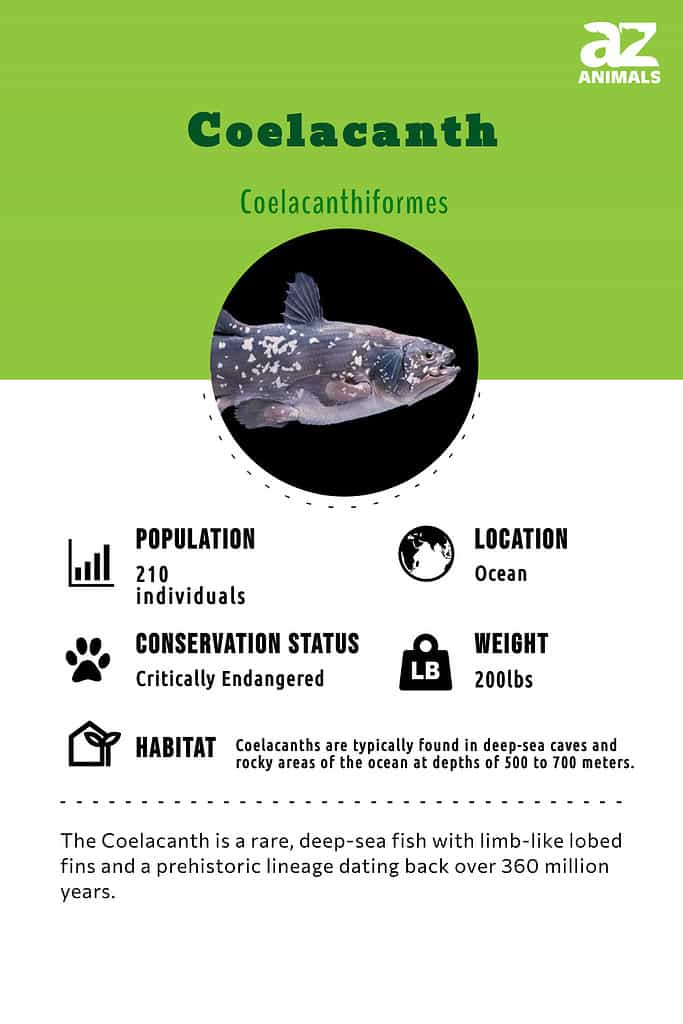
The coelacanth first evolved almost 400 million years ago.
The coelacanth is one of the best-known examples of a “living fossil”: the living remnant of an ancient lineage of fish dating back nearly 400 million years. Just to be clear, the term living fossil does not mean that the modern coelacanth fish is completely unchanged. Characteristics like color and behavior have undergone some modifications.
It just means that this fish has retained the major characteristics from its ancient lineage that no longer exist in other species or became very rare over time. This species was thought go extinct around the same time as the dinosaurs some 65 million years ago.
But the discovery of this fish in 1938 by a South African museum curator caused a sensation in the scientific community. Because of its rarity, any specimen is prized for its potential value in scientific study.
3 Coelacanth Facts
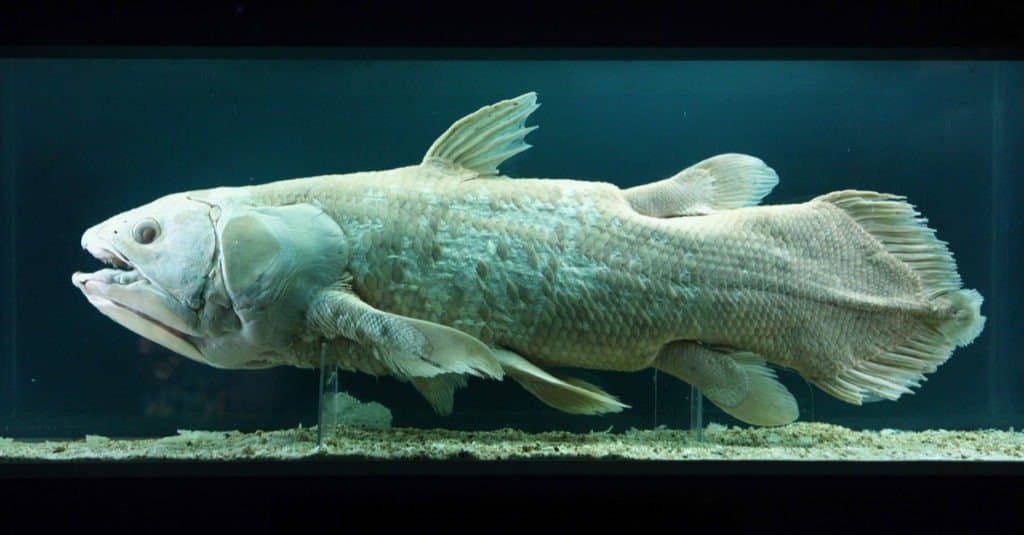
The coelacanth fish has the ability to live in depths of up to 2,300 feet, and its vision is well-suited for navigating in this deep water habitat.
©Vladimir Wrangel/Shutterstock.com
- The coelacanth fish can live up to depths of some 2,300 feet. Its vision is well-adapted for seeing in this deep water environment.
- The coelacanth fish has a truly tiny brain that makes up only 1.5% of its total cranial cavity. The rest of the cranium is filled with fat.
- This is one of the many fishes you can catch and proudly display in your aquarium in the popular Nintendo video game series Animal Crossing.
Classification and Scientific Name
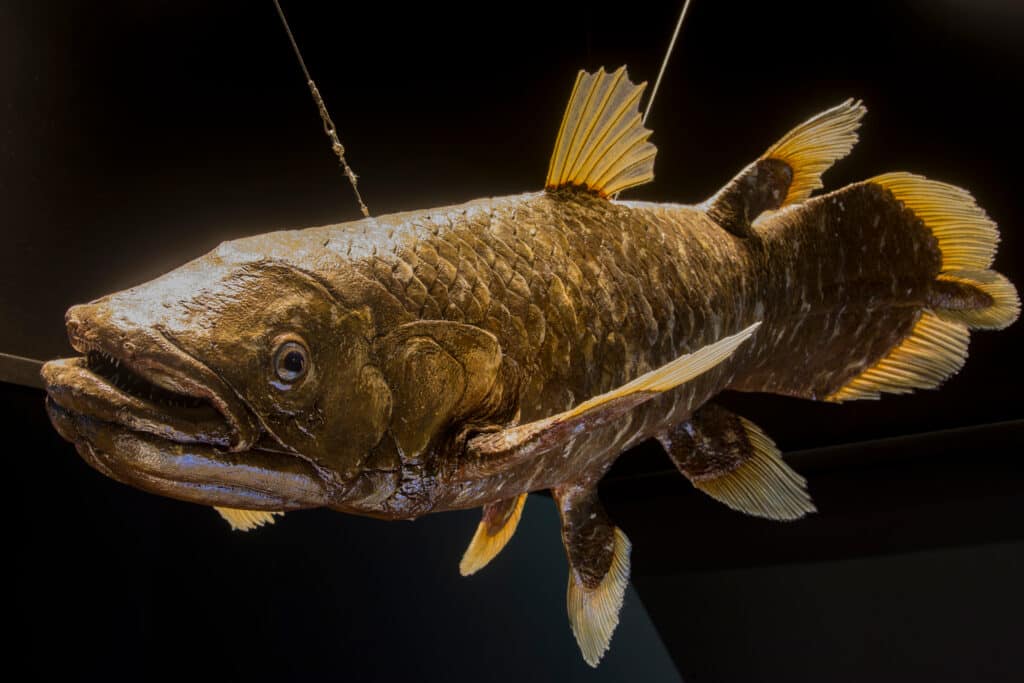
Coelacanthiformes is the scientific name of the entire coelacanth order, which includes both living species and extinct ones.
©Danny Ye/Shutterstock.com
The scientific name of the entire coelacanth order (including both living species and extinct ones) is Coelacanthiformes. The name coelacanth appears to derive from a Greek word meaning a hollow spine (which is a very apt description of its physiology).
Latimeria is the name of the genus for all currently living species of coelacanths. This was given by taxonomists in honor of Marjorie Courtenay-Latimer, who’s credited with the discovery of the fish in 1938.
Evolution and Origins
Located in the Hall of Vertebrate Origins, the coelacanth was previously believed to have gone extinct around 70 million years ago, until a live specimen was discovered off the coast of South Africa in 1938; since then, approximately 200 more coelacanth specimens have been found in the western Indian Ocean.
Coelacanths are primarily found in the Comoros Islands located in the Western Indian Ocean between Madagascar and the east coast of Africa, but they can also be found in other areas along the east African coast as well as in Indonesian waters.
Coelacanths have been recorded in the fossil record for over 360 million years, with their highest abundance about 240 million years ago, and were previously believed to have gone extinct around 80 million years ago until a living specimen was discovered in 1938.
Species
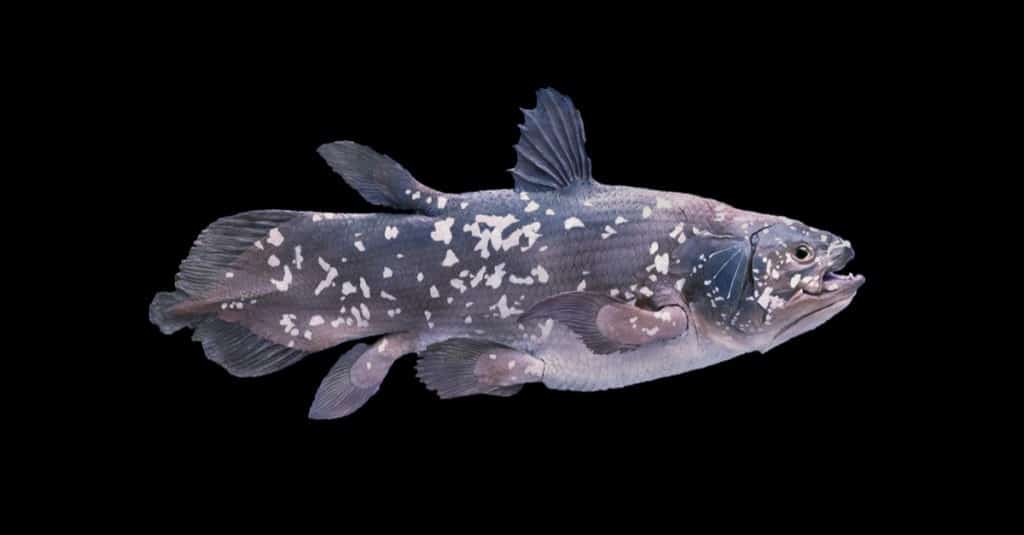
The coelacanth order was previously comprised of approximately 90 identified species, but now only two extant species of coelacanth remain.
©AlessandroZocc/Shutterstock.com
The coelacanth once included around 90 known species. Now there are only two living species of coelacanths left.
- West Indian Ocean Coelacanth – Latimeria chalumnae, as it’s referred to in the proper scientific form, was the first coelacanth species ever found by humans. It is characterized by a blue scale (which actually turns brown after death) with white spots. This species was first discovered around the Comoros Islands between the African mainland and Madagascar, but in recent decades, other groups have also been found along the entire East African coast between Kenya and South Africa.
- Indonesian Coelacanth – The discovery of a second species, Latimeria menadoensis, was made in 1997 off the coast of Indonesia. It has a brownish-grey color with white spots, but it is otherwise quite similar to the other species. Genetic evidence suggests it may have split off from its West Indian counterpart more than 10 million years ago.
Appearance
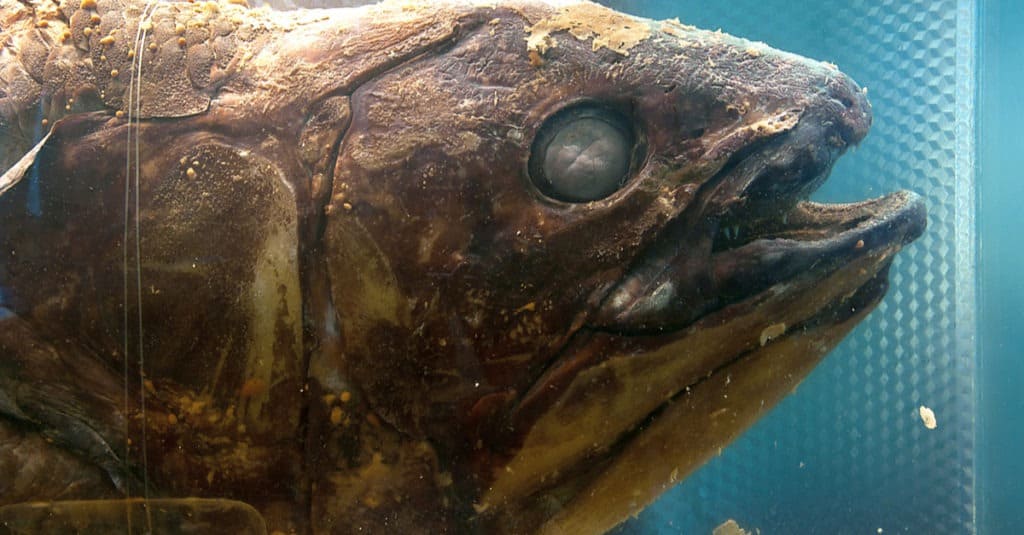
The coelacanth belongs to the group of lobe-finned fish, which are distinguished by their limb-like lobed fins.
©Openfinal/Shutterstock.com
The coelacanth is an example of a lobe-finned fish. The defining characteristic of this class of fish is the presence of limb-like lobed fins. Protruding from the body, these fins contain many bones and muscles that move in an alternating pattern much like the trotting of a horse.
This is quite different from the wave-like motion employed by many other fish species. It has been suggested that this fish has changed so little from its ancestral origins because of a stable habitat, lack of serious predators, or other factors that would normally drive large evolutionary change.
Another defining feature of the coelacanth is the presence of the notochord, a hollow oil-filled tube that functions as a kind of backbone. Every single chordate on the planet (mammals, reptiles, fish, sea squirts, etc) grows a notochord at some point in their lives, but it’s almost always lost at an early stage of development in favor of the vertebrae. By contrast, the coelacanth retains the rather elastic notochord for its entire life as a replacement for the vertebrae it’s missing.
The coelacanth has several other unusual characteristics. The skull has a hinged joint that can open wide to consume large prey. The snout contains a “rostral organ” as part of a sensory system for detecting the electrical elements of its surroundings. And a vestigial fat-filled lung surrounded by hard plates is believed to play a similar role to the swimming bladder by providing the coelacanth with buoyancy.
The modern coelacanth is a massive fish that can reach up to 6.5 feet in length and weigh almost 200 pounds. But this is a minnow compared to some species of larger extinct coelacanths that reached up to 21 feet in size.
Distribution, Population, and Habitat
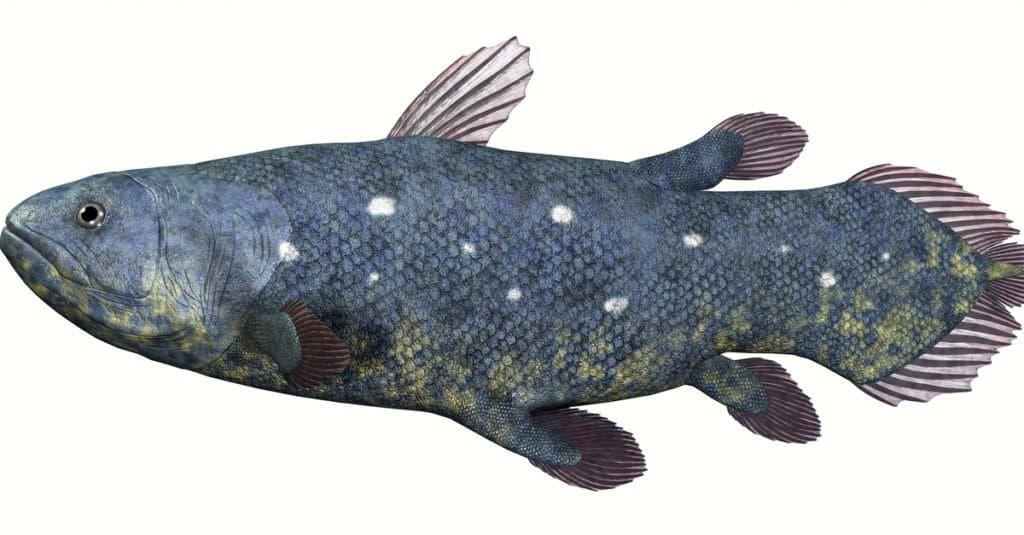
Given the infrequent discovery of this fish, it’s challenging to determine definitively its potential distribution beyond its known habitats.
©Catmando/Shutterstock.com
Since this fish is so rarely found, it is difficult to say with any degree of certainty where else it might reside. The only known species appear to have a sporadic distribution across the coasts of East Africa and Southeast Asia. The coelacanth spends most of the daytime hiding in underwater caves and then comes out to feed at night.
The IUCN Red List currently classifies the West Indian Ocean coelacanth as critically endangered, while the Indonesian coelacanth is merely vulnerable. A lack of knowledge about its habits has hampered some conservation efforts, but a focus on simply reducing accidental catches may go a long way to preserving the fish.
Predators and Prey
The coelacanth is something called a passive drift feeder that moves slowly through the water and picks up whatever prey happens to be passing by. It is believed to occupy near the top of the food chain, but due to the presence of bite marks on some specimens and a developed fight or flight response, there may be some predators above it that have no inhibition about chomping into a coelacanth.
What does the coelacanth eat?
The coelacanth is known to feast primarily on many smaller species of fish, including the splendid alfonsino, the brotula barbata, the cardinal fish, and the bronze whiptail. It also feeds on cephalopods such as octopus, squid, and cuttlefish.
What eats the coelacanth?
No predator has ever been directly observed to consume a coelacanth, but it’s been suggested that sharks may sometimes feed on it.
Reproduction and Lifespan
Direct observations of coelacanth reproduction are very rare, and what we know must be inferred from their anatomy and genetic studies. Whereas most species of fish engage in external fertilization, the female coelacanth appears to fertilize the eggs internally.
The males seem to lack a sexual organ of any kind but do possess a modified hole or orifice that may serve the same purpose.
What we know from some captured specimens is that the females can produce anywhere between five and 26 developed young at a time (though maybe more) through live birth.
The young coelacanths have a very long development time compared to most fish and require a lot of investment from the mother (but seemingly no investment from the father). Since the female spends so much time on the young, this delays reproduction to every two or three years.
The precise life expectancy is currently unknown. Coelacanths appear to live at least 20 years in the wild, but it has been suggested that their life span may exceed 100 years.
Fishing and Cooking
The coelacanth is a rare and protected fish that plays no role in human cuisine or recreational fishing, but it is sometimes accidentally caught by people from gill nets or near-shore deep-water fishing.
View all 235 animals that start with CCoelacanth FAQs (Frequently Asked Questions)
How do you pronounce coelacanth?
The name isn’t quite pronounced how it looks. The true pronunciation is seel-uh-kanth.
How many coelacanths are left?
Population numbers are not known, but it’s estimated to be in the hundreds.
When did the coelacanth first appear?
The earliest coelacanth fossil dates back to around 360 million years, but genetic evidence suggests that the coelacanth probably first appeared some 390 or 400 million years ago, back when it split with the lineage that would eventually produce land-based tetrapods (all four-legged vertebrates), though the fish’s evolution is a matter of some controversy. It is thought to be more closely related to the almost equally ancient lungfish than most ray-finned fish, which make up the bulk of modern fish species.
Is the coelacanth still alive?
There are two currently recognized species of coelacanths still around, but their survival is precarious.
Are Coelacanths herbivores, carnivores, or omnivores?
Coelacanths are Carnivores, meaning they eat other animals.
What Kingdom do Coelacanths belong to?
Coelacanths belong to the Kingdom Animalia.
What is an interesting fact about Coelacanths?
The Coelacanth first evolved almost 400 million years ago.
Thank you for reading! Have some feedback for us? Contact the AZ Animals editorial team.
Sources
- National Geographic, Available here: https://www.nationalgeographic.com/animals/fish/group/coelacanths/
- Smithsonian, Available here: https://ocean.si.edu/ocean-life/fish/coelacanth
- Animal Diversity Web, Available here: https://animaldiversity.org/accounts/Latimeria_chalumnae/
















